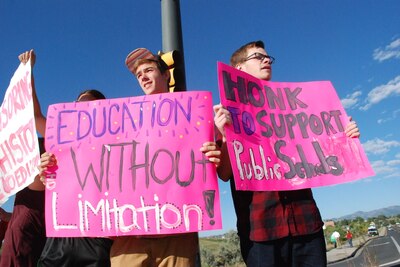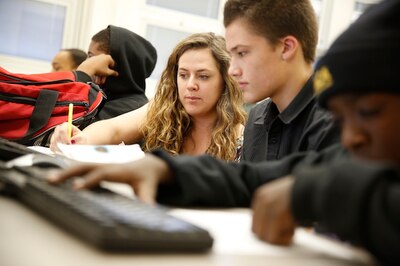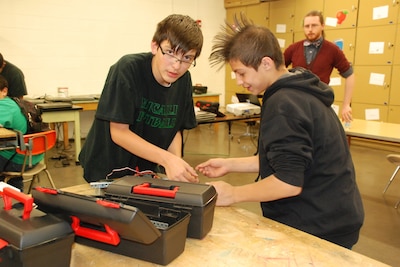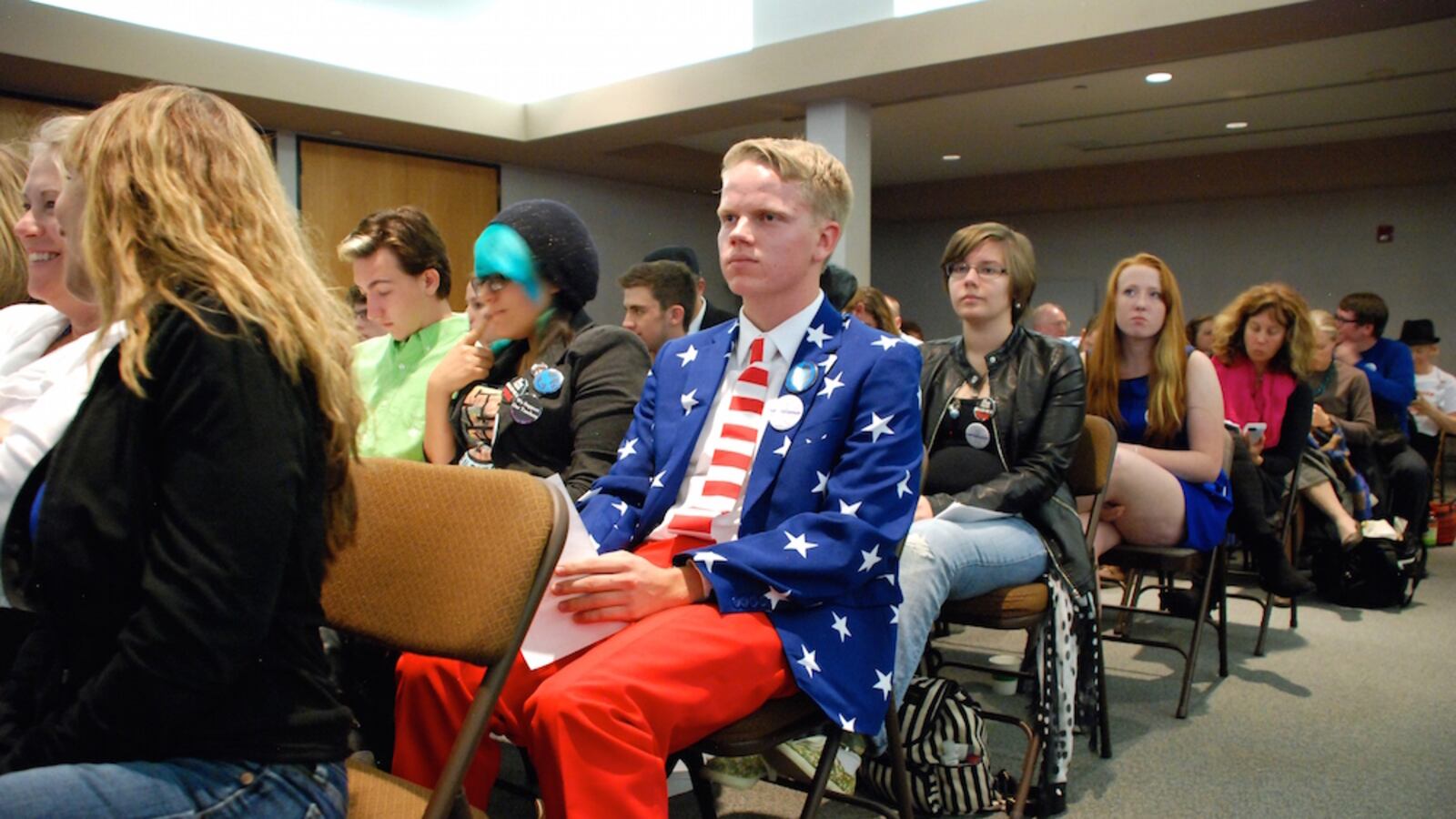As 2014 year comes to a close, Chalkbeat Colorado looked back to identify the stories and themes that had the largest impact on classrooms across Colorado. Major themes included discontent about testing and school funding, school improvement efforts that are and in many cases aren’t working, and questions of leadership by principals and school board members.
Students take to the streets
“The students of Jeffco are standing up for themselves, and for their friends, family, teachers and most importantly, their education. So are you with us?” — Jessica Yan, Standley Lake High School student
Colorado students along the Front Range made sure their frustrations — on a variety of issues — were heard loud and clear this year.
Students in Jefferson County, Boulder, Denver, and Aurora left their desks for a string of protests against their school board, standardized testing, and two grand jury decisions not to indict white police officers in the deaths of black men in Missouri and New York.
While the issues were not connected, the series of student-led protests stretched from September through December. Adult reaction to the walkouts was mixed. Most school and civic leaders in Jefferson County and Boulder marveled at the walkouts. Others wondered out loud about the influence of adults on the student’s decisions to protest. And Denver Mayor Michael Hancock pleaded with students to return to class.
In Jeffco, students have vowed to keep an eye on the school board. Adults behind the opt-out movement plan to capitalize on the largest public demonstration against testing to date. And Denver school and city leaders are hosting conversations about race relations. But whether any systemic change comes from the protests is still unclear.
Testing backlash
“Colorado still has to have that conversation — what is that we want from our state system. I think that conversation should be occurring.” — Joyce Zurowski, executive director of assessment at CDE
Students in Boulder weren’t the only ones — and certainly not the first — upset about changes to Colorado’s testing system. Since the start of the 2014 legislative session, some Coloradans have been been engaged in a renewed debate about how many exams students should be asked to take, and for what purpose.
While the debate about standardizing testing is not new, it has become increasing charged due to two main factors. First, individuals and organizations who respectively oppose the Common Core State Standards, which the state had adopted, and standardized testing have found commonalities in their issues. In some instances, they’ve joined forces. Second, this is the first year of new computer-based assessments, which seem to be eating up more class time and causing logistical headaches, some school leaders claim.
A panel created by the Colorado General Assembly is expected to make recommendations to the legislature early next year on how the state’s testing system should change.
The fight over the negative factor
“We have much ground to make up in school funding. We made some good progress this year, but we are nowhere close to making a proper investment in our public schools.” — Kerrie Dallman, president of the Colorado Education Association
After voters soundly defeated a constitutional amendment that would have raised an additional billion dollars for schools in November 2013, the coalition of education interests behind that proposal found itself in disarray and split by deep disagreements over the path forward.
Want more?
Take a longer and deeper look back at 2014 with the Chalkbeat Colorado yearbook. Get yours today when you donate to our end of year campaign here.At the heart of the disagreement was the negative factor, a mechanism that the legislature created during the recession to cut the state’s basic school funding. School superintendents and school boards argued that the legislature should focus on backfilling years of cuts driven by the negative factor, and that money should come with no strings attached so that they could restore whatever programs they’d been forced to trim.
But others, including Gov. John Hickenlooper, argued that new school funding could be used as a driver of educational improvement if used in very specific ways to support programs like early literacy and English language instruction.
The two main finance bills, the Student Success Act and the School Finance Act, were introduced in late February. But the arguments, negotiations, and amending continued until the last day of the session, when the House approved the final version of the finance act.
While it’s likely schools will get even more money next year, superintendents are lobbying lawmakers and the governor to ensure that money comes without conditions. And a lawsuit challenging the constitutionality of the negative factor is making its way through the court system now.
Jeffco interrupted
“Organizations founder when there is instability. Like any corporation, where there is infighting and distraction among leadership, the organization loses direction.” — David Bloomfield, Brooklyn College and the CUNY Graduate Center professor

For many years, the Jefferson County school district was the epitome of a suburban school district in Colorado. Most of the 85,000 students in the district performed better than their peers across the state on standardized exams and the district was seeing rising graduation rates.
But in 2013, a new majority, with strong conservative ties, was elected to the school board.
Their message: we can do better. In little more than a year that board has hired a new superintendent; given more money to charter schools in order to close a past funding disparity; and developed a new compensation system for teachers that rewards teachers that earn the highest evaluation rating.
But along the way, critics of the board majority believe they rushed to half-baked decisions; the board chairman failed to comply with open records requests; and one member proposed a curriculum review committee to ensure U.S. history is patriotic which triggered weeks of acrimony and national headlines.
Rumors of a possible recall effort continue to swirl throughout the sprawling suburban county, which also serves as an election bellwether. But opponents to the board majority face an expensive uphill battle if they want to make that happen.
Denver’s new plan emphasizes racial equity, closing opportunity gap
“I can’t worry about tomorrow. That’s not my job. My job is to make sure these kids get to high school. They deserve it.” — Elza Guajardo, Kepner middle school principal

In August, the Denver Public Schools Board of Education approved a new and slimmed-down strategic document. The aim: to increase the number of quality school options available to families and close stubborn racial achievement gaps. With the self-congratulating phase over, all eyes are on several big moves aimed at improving equity and access to top educational pr grams throughout the district.
The quality of schools in southwest Denver, which is home to some nearly a fourth of all Denver students, has for years been the subject of concern and discontent. But that’s starting to change, as the district has made reform in southwest Denver — particularly at the neighborhood’s struggling Kepner Middle School — a priority. But not everyone agrees on the best path forward for schools in the southwest. Possible fault lines in the debate include whether new schools that open in the neighborhood should be charter or district-run, and how those schools should best serve the neighborhood’s many students learning English.
And across town, the IB program at George Washington High School has for 30 years educated a small group of high-performing students and sent many of them off to some of the nation’s most elite colleges. The rigorous four-year program admits students based on grades, test scores, teacher recommendations and interviews. But in an effort to make the program more inclusive, district officials are opening up the pre-IB program to a much wider swath of students. The move caused an uproar among families at the school, many of whom worry that broadening the program will dilute its rigor.
A promise of improvement at Denver’s Manual High School flounders
“A lot happened this year that we can’t get back. If we can get thought this year, next year will be good.” — John Goe, Manual art teacher
Eight years after Denver Public Schools officials rebooted struggling Manual High School, promising to rebuild it as a world-class school for northeast Denver, the school had once again fallen away from the public eye and languished as the city’s lowest-performing high school.

But that changed in 2014, after Chalkbeat reporters detailed the rise and fall of reform efforts at the school and Denver officials attempted a dramatic and at times controversial mid-year course correction.
Chalkbeat’s months-long reporting effort found many factors that hindered the school’s efforts to provide a high-quality education for its students, including a continuously tense relationship with the district that stretched through the tenure of three principals over seven years and mismanagement of the school’s budget, which forced staff to abandon key parts of the school’s instructional program.
A week after Chalkbeat’s series ran, Denver officials replaced the school’s principal.
New principal Don Roy made immediate changes to the school, some small and some more significant. He brought on more school security and implemented tighter disciplinary rules. He also backpedaled from some elements of the school’s model, including an extended school calendar that had left many students and staff burnt out. And in June, Roy announced that he would not renew the contract of the school’s assistant principal Vernon Jones, a decision that drew protests from many community members who felt Jones was their connection to and voice in the school.
DPS quietly and shortly considered merging Manual with its flagship high school, East. But community outrage from both campuses squashed that idea. The district is now searching for a new principal to lead Manual in the 2015-16 school year.
In DPS, principal turnover is highest where improvement intentions are most intense
“The notion that great systems can exist without great principals is ridiculous.” — Tom Boasberg, DPS superintendent
A key and very public strategy the Denver school district has touted has been its reform of how it hires, trains, and retains its school leaders. And while Denver’s overall principal turnover rate has fallen by almost half in recent years, churn of school leaders has not slowed at nearly a quarter of Denver schools, where three or more principals have come and gone since 2008.

That turnover, according to a Chalkbeat analysis of state records, is concentrated in schools where the district has pushed its most intense improvement efforts, schools that researchers say are most in need of high quality and steady leadership. Principals have been thrust into struggling schools with little training, given support that feels more more burdensome than beneficial, and held to expectations that some describe as impossibly too high.
As schools lose principals to burnout or officials move them out, rocky transitions disrupt students’ classrooms and leave communities feeling isolated from their schools.
District leaders say that they are beginning to take steps to understand Denver’s principal churn in order to figure out what to fix. For example, most principals now have development coaches.
The struggles of Steel City’s turnaround
“If the state has all the answers, why are they waiting for five years?” — Rod Slyhoff, Pueblo Greater Chamber of Commerce

It’s becoming increasingly likely the 18,000 student Pueblo school district will be the first big test of the state’s school accountability system, which gives struggling schools and districts five years to improve or face sanctions. Of the dozen or so school districts that are less than a year away from having a conversation with the state about its accreditation, Pueblo City Schools is the largest.
At risk is a loss of federal funding; students’ diplomas will likely be worthless; and the city’s reputation, which was once nationally recognized for teaching students of color how to read well, and its economic recovery is on the line.
The struggle to improve the city’s schools has been fought on many fronts. And to better understand how a school district with a large concentration of poor and Latino students works to improve itself, Chalkbeat spent the spring interviewing dozens of district officials, teachers, principals, students, and community members.
In one case, the city designed a socioeconomically diverse school where most students are succeeding. But in doing so, the district also unintentionally created the state’s lowest performing middle school that has struggled to keep a principal more than a year.


